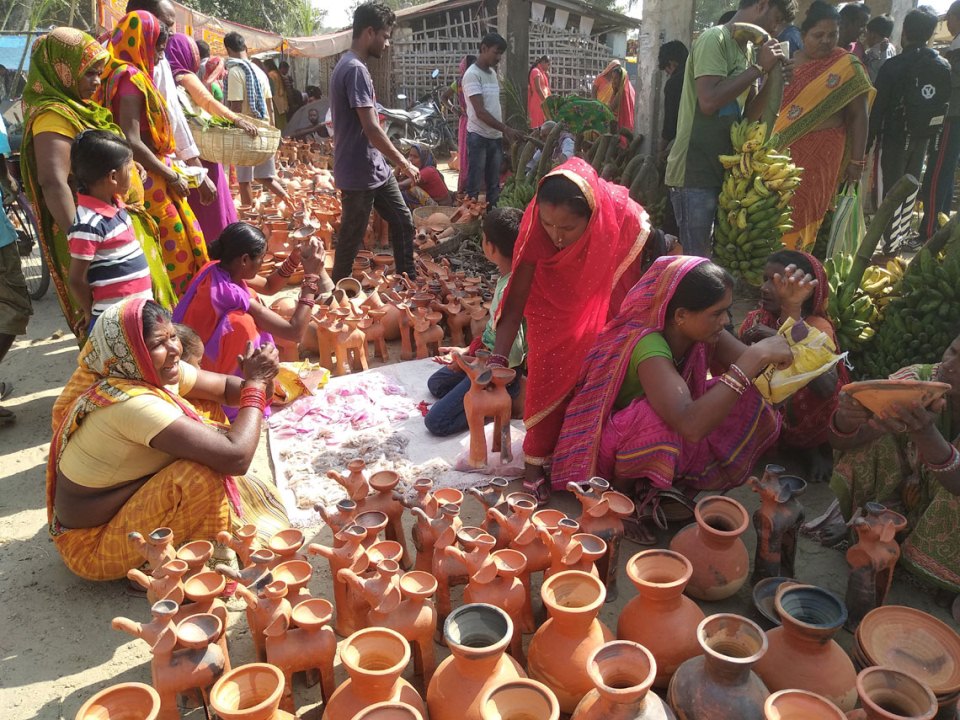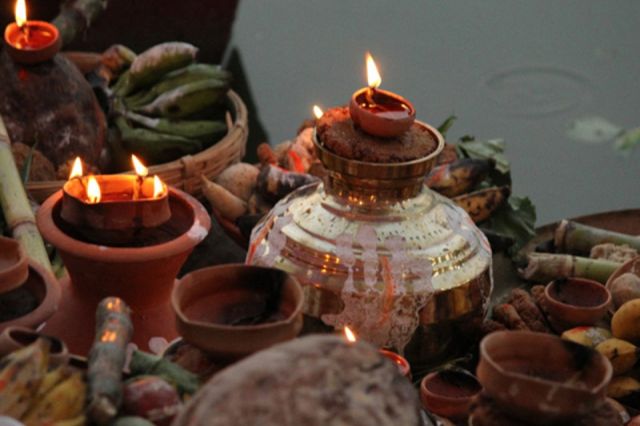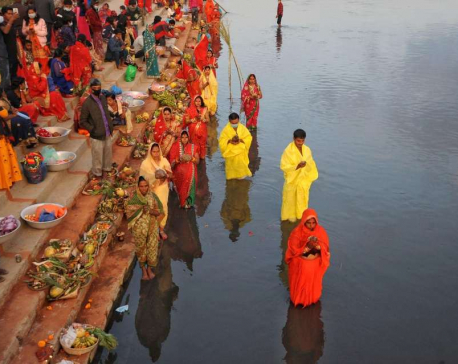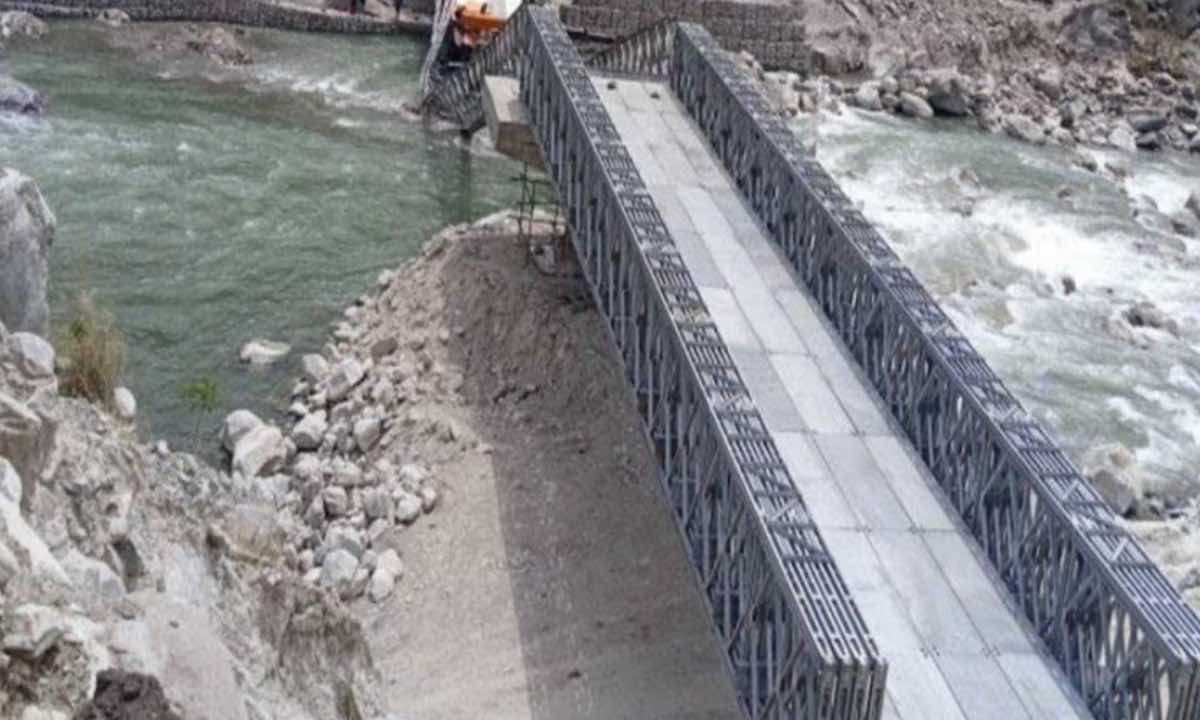
OR
Main rituals of Chhath festival to begin on Thursday
Published On: October 30, 2019 10:30 AM NPT By: RSS

JANAKPURDHAM, Oct 30: The rituals associated with the Chhath festival are commencing from Thursday.
Chhath is a festival mainly dedicated to the Sun God. It is a cultural and religious festival that indicates to the human civilization and an occasion for expressing gratitude to the nature.
The sun is especially worshiped amidst various rituals and by making different kinds of offerings. The main rituals of the festival, observed in succession in a period of four days, include the arba-arbain, kharana, offering argha to the setting sun and offering argha to the rising sun. The arba-arbain ritual is observed on the first day (Chaturthi) which falls on Thursday this year. This ritual is also called nahaya-khaya.

The devotees start observing fast from this day abstaining from eating meat and fish, onion, garlic, millet and yellow lentils. They take holy dips in ponds and rivers on this day in the early morning and start the fast. On the second day (Panchami), the kharana ritual is observed, which is also known as 'diluting away the sins'.
The place where the Chhath rituals are conducted is daubed with a mixture of cow dung and water. A paste prepared by mixing the Arba rice flour and holy water is sprinkled over the place and the altar for performing the Chhath rituals is anointed.
The devotees observe a complete fast on this day even without drinking water. They offer payas (rice pudding) to the moon after moon rise and partake this offering. On the third day of the festival (Shasthi), various delicacies are prepared out of the flour of rice and wheat grains grinded in traditional grinders (okhal, jaanto or dhiki).
All the members of the family go to the assigned water body, ponds or the bank of the river, carrying a variety of offerings, amidst the singing of devotional and folk songs. The offerings include the delicacies like thakuwa, bhusawa, khajuri, perukiya; fruits like coconut, orange, banana, citrus fruits; and other articles as nanglo, koniya, saraba, dhakan, elephant terracotta idol. These offerings are all carried in a big basket. Before placing the offerings on the bank of the river or pond, the devotees prostrate five times in front of the spot and the offerings.
The members of the family draw the 'aripan' sketches as per the tantric methods at the place beforehand to sanctify it. Thereafter, the devotees step into the water of the pond and river and worship the setting sun for making the offerings. The parvan rituals are observed on the fourth day or the last day of the Chhath festival.
On this day, the devotees go to the bank of the pond or river to the place which is specially anointed for the rituals in the early morning. They repeat the rituals conducted in the previous evening and make offerings of argha to the rising sun. After done with the argha rituals, the devotees listen to the chanting of the Surya Purana scripture by the priests. They also listen to and narrate the story related to the Chhath fasting. Chhath is such festival in the world considered as an attractive custom of the tradition of worshipping the sun in which both the rising and setting sun is worshipped and presented different offerings.
As per the oriental philosophy, human civilization developed on river banks and the sun and water are the most essential elements out of the five main elements that sustain life on the Earth. The Chhath festival is an occasion to pay obeisance to these five elements. Sun worship is the main theme of this festival and it embodies the message of mutual good will, unity and co-existence.
The sun is the basis of existence of life, nature, planets, constellations, time and epochs. The festival also celebrates the life-sustaining energy of the sun and the Chhathi goddess. So both the sun god and chhathi goddess are worshipped during the Chhath festival. Worshipping the male and female form on this occasion means showing respect to the natural form of creation of life on this Earth.
The sun is also considered the god of health and prosperity. The fasting observed during this festival is considered one of the most rigorous of fasting. The Chhath festival which used to be marked only in the Mithilanchal region before is now celebrated in the hilly areas and other regions as well. Its popularity is growing in Nepali society these days.
You May Like This

Chhath festival begins with 'Nahay Khay'
MAHOTTARI, Nov 17: Ardor of the Chhath festival has taken over the Mithila region. People's mobility has increased in and... Read More...
_20211110163458.png)
Sastodeal brings ‘Maha Chhath Festival’ on the occasion of Chhath
KATHMANDU, Nov 10: Sastodeal, an online marketplace in Nepal has introduced ‘Maha Chhath Festival’ starting from 10th November to 12th... Read More...

Devotees make offerings to Sun God during Chhath
RAUTAHAT, Nov 14: Devotees observed the Chhath festival by making offerings to the setting sun on Tuesday. The festival of... Read More...
Just In
- Gold items weighing over 1 kg found in Air India aircraft at TIA
- ACC Premier Cup semi-final: Nepal vs UAE
- Sindhupalchowk bus accident update: The dead identified, injured undergoing treatment
- Construction of bailey bridge over Bheri river along Bheri corridor reaches final stage
- Taylor Swift releases ‘The Tortured Poets Department’
- India starts voting in the world’s largest election as Modi seeks a third term as prime minister
- EC seeks cooperation for free and fair by-election
- Bus carrying wedding procession attendees meets with accident in Sindhupalchowk; three killed



















Leave A Comment